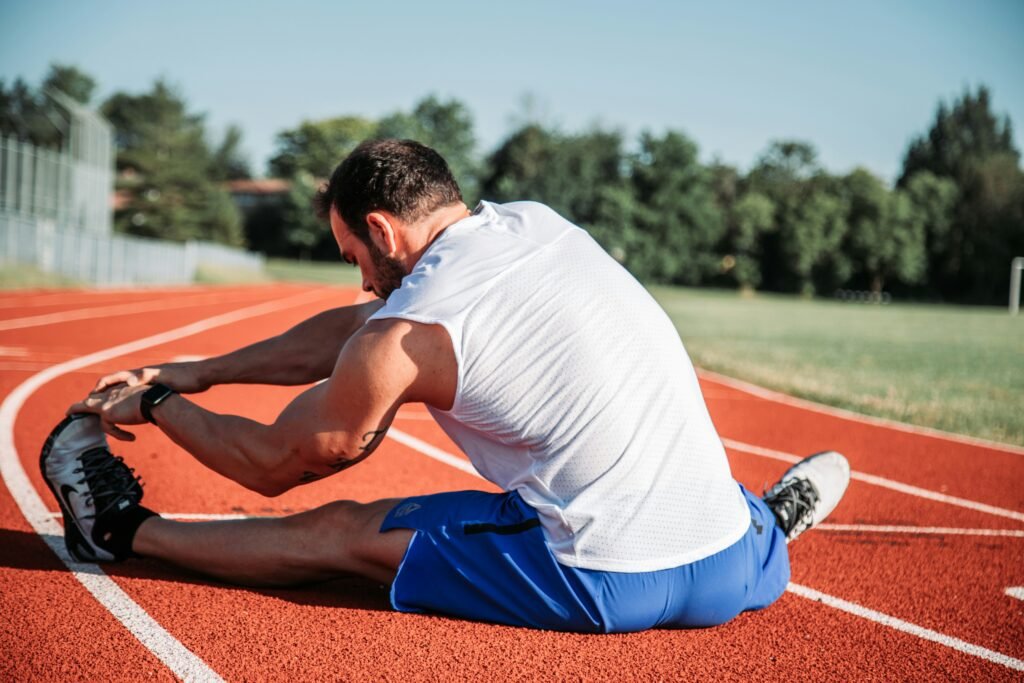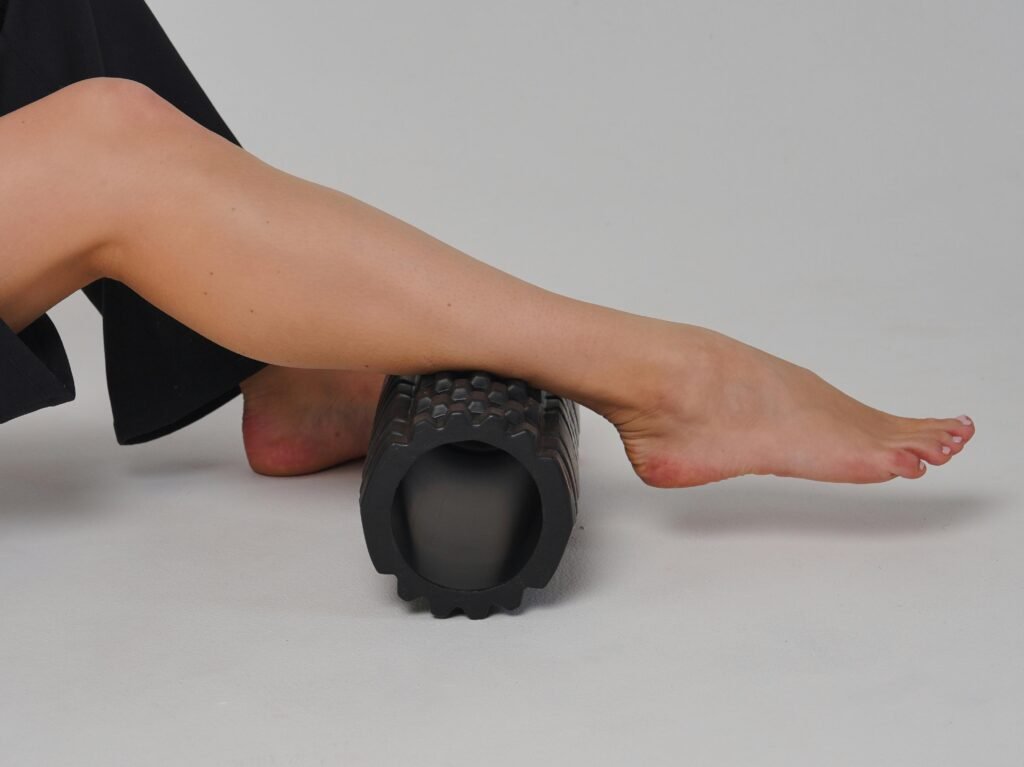Last updated: August 2025
Burning muscles and muscle aches are part of hiking. Every experienced hiker has been there: you’ve just tackled a tough trail, your legs are on fire, and all you want to do is crash. But here’s what many hikers don’t realize—skipping your recovery routine afterward sets you up for injuries, lingering soreness, and weaker performance on your next adventure. Here’s where stretching comes in.
This guide walks you through everything you need to know about recovery—from must-do stretches to advanced mobility drills—so you can stay trail-ready year-round.
Table of Contents
*This post may contain affiliate links. If you use them, I may earn a small commission at no extra cost to you.
Post-Hike Fatigue Symptoms
It’s completely normal to feel drained after a long hike—your body just pushed through hours of climbing, balancing, and carrying weight. Post-hike fatigue can show up in a few ways:
- Heavy legs & soreness – Muscles may feel stiff or wobbly, especially in your calves, quads, and hips.
- Low energy – You might feel unusually tired or sluggish even after sitting down.
- Dehydration signs – Headache, dry mouth, or dizziness can creep in if you didn’t drink enough.
- Brain fog – Mental fatigue often follows physical effort, making it harder to focus.
- Delayed soreness – DOMS (delayed onset muscle soreness) usually hits 24–48 hours later, peaking in intensity before easing off.
Recognizing these symptoms early helps you recover faster. Pairing light stretching with proper hydration, food, and rest not only reduces discomfort but also preps your body for your next hike.
Why Post-Hike Recovery Matters
The Science of Hiking Recovery
Hiking, especially on tough terrain, puts heavy stress on your body. If you are just starting out, you probably want to into training for hiking – this can make your recovery faster. Just training in advance is not enough though in addition climbing uphill works your glutes, quads, and calves, while descending pounds your knees and lower legs. Without proper recovery, this often results in:
- Muscle soreness that kicks in 24–72 hours later (DOMS)
- Reduced flexibility in key hiking muscles
- A higher chance of injuries on your next trek
- Weaker performance and lower stamina
Benefits of Recovery Done Right
Consistent post-hike recovery pays off with real results:
- Cuts muscle soreness by up to 40% (backed by sports medicine research)
- Keeps your muscles flexible, boosting hiking performance
- Prevents common overuse injuries
- Improves blood flow for faster healing
- Preserves joint mobility for better balance and stability on the trail
Essential Hiking Stretches: Your Post-Trail Routine
The best time to stretch is within 30 minutes of finishing your hike, when your muscles are still warm. Hold each stretch for 30-45 seconds and repeat 2-3 times.
1. Standing Hamstring Stretch (Must-Do After Steep Descents)
Target muscles: Hamstrings, calves, lower back
How to perform:
- Find a rock, log, or car bumper about knee height
- Place your heel on the surface, keeping your leg straight
- Lean forward from your hips (not your back) until you feel the stretch
- Keep your standing leg slightly bent for stability
Why it works: Steep descents tighten your hamstrings significantly. This stretch prevents the “walking like a robot” feeling the next day.
2. Standing Quad Stretch (Essential for Uphill Recovery)
Target muscles: Quadriceps, hip flexors
How to perform:
- Stand tall and grab your ankle behind you
- Pull your heel toward your glutes
- Keep your knees together and hips square
- Use a tree or hiking pole for balance if needed
Pro tip: If you can’t reach your ankle, use a towel or strap to assist the stretch.
3. Calf Stretch Against Tree or Rock
Target muscles: Gastrocnemius, soleus, Achilles tendon
How to perform:
- Place your hands against a tree or large rock
- Step your right foot back 2-3 feet
- Keep your heel flat and leg straight
- Lean forward until you feel the stretch
- Repeat with left leg
Why it’s crucial: Tight calves are the #1 cause of next-day hiking soreness.
4. Hip Flexor Lunge Stretch
Target muscles: Hip flexors, psoas, quadriceps
How to perform:
- Step into a lunge position with your right foot forward
- Lower your left knee toward the ground
- Push your hips forward while keeping your torso upright
- Feel the stretch in the front of your left hip
- Switch sides
Best for: Hikers who carry heavy packs or do lots of uphill climbing.
5. Figure-Four Glute Stretch
Target muscles: Glutes, piriformis, outer hips
How to perform:
- Lie on your back (use a yoga mat or soft ground)
- Cross your right ankle over your left knee
- Grab behind your left thigh and pull toward your chest
- Keep your head relaxed on the ground
- Switch sides after 30-45 seconds
Alternative: Can be done seated on a rock or car tailgate.
6. Seated Spinal Twist
Target muscles: Spine, obliques, glutes
How to perform:
- Sit with legs extended
- Cross your right leg over and place foot outside your left knee
- Rotate your torso to the right, using your left elbow against your right knee
- Look over your right shoulder
- Hold and repeat on the other side
Complete Post-Hike Recovery Routine (15-Minute Protocol)
Immediate Post-Hike (First 30 Minutes)
Step 1: Cool Down Walk (5 minutes) Never go from hiking intensity to complete rest. Walk slowly for 5 minutes to gradually lower your heart rate.
Step 2: Essential Stretches (10 minutes) Perform the 6 stretches above in order, holding each for 30-45 seconds.
Step 3: Hydration Check Drink 16-24 ounces of water, plus electrolytes if you’ve been hiking for more than 2 hours.

Within 1-2 Hours Post-Hike
Nutrition for Recovery:
- Protein: 20-25 grams for muscle repair (Greek yogurt, protein shake, lean meat)
- Carbohydrates: 30-40 grams to replenish glycogen (banana, oatmeal, sweet potato)
- Anti-inflammatory foods: Tart cherry juice, turmeric, leafy greens
Example recovery meals:
- Turkey and avocado wrap with spinach
- Greek yogurt with berries and granola
- Chocolate milk and a banana (surprisingly effective!)
More on recovery nutrition: Hiking Nutrition: What to Eat Before, During & After for Best Performance
Evening Recovery Protocol
Cold Therapy (Optional but Effective):
- Cold shower for 3-5 minutes, focusing on legs
- Ice bath for 10-15 minutes if available
- Contrast showers (hot/cold alternating)
Heat Therapy:
- Warm Epsom salt bath (20 minutes)
- Sauna session if available
- Heating pad on sore muscles
Hiking Mobility Exercises for Better Trail Performance

Mobility work differs from stretching – it’s about moving your joints through their full range of motion actively. Incorporate these 2-3 times per week:
Dynamic Warm-Up Exercises (Pre-Hike)
Leg Swings (Front to Back)
- Hold onto your car or a tree for balance
- Swing one leg forward and back 10-15 times
- Keep your core engaged and standing leg slightly bent
- Switch legs
Leg Swings (Side to Side)
- Same setup, but swing your leg across your body
- 10-15 reps each leg
- Great for hip mobility
Walking Lunges with Rotation
- Step forward into a lunge
- Rotate your torso toward your front leg
- 5-6 reps each side
- Prepares hips and spine for uneven terrain
Post-Hike Mobility Work
Cat-Cow Spinal Movement
- Start on hands and knees
- Arch your back (cow), then round it (cat)
- 8-10 slow repetitions
- Restores spinal mobility after carrying a pack
Ankle Circles and Flexion
- Sit comfortably and rotate each ankle 10 times each direction
- Point and flex your toes 10 times
- Prevents ankle stiffness and reduces injury risk
Recovery Tools Every Hiker Should Consider

Essential Recovery Equipment
Foam Roller ($15-40)
- Best for: IT band, quads, calves, and glutes
- How to use: Roll slowly, spending 30-60 seconds on tight spots
- When: 24-48 hours after hiking (not immediately post-hike)
Massage Gun ($50-300)
- Best for: Deep muscle tension, trigger points
- Benefits: Increases blood flow, reduces muscle stiffness
- Usage: 30-60 seconds per muscle group, low to medium intensity
Compression Gear ($20-80)
- Compression socks: Improve circulation during and after hikes
- Compression shorts/tights: Reduce muscle oscillation and fatigue
- Best practice: Wear during long hikes, keep on for 2-4 hours post-hike
Advanced Recovery Tools
Percussion Massage Devices
- Brands like Theragun, Hypervolt, or budget alternatives
- Most effective on large muscle groups (quads, glutes, calves)
- Use for 30-90 seconds per muscle group
Recovery Boots (Compression Therapy)
- Professional-grade tools used by athletes
- 20-30 minute sessions improve circulation dramatically
- Investment piece for serious hikers ($300-800)
Common Hiking Recovery Mistakes to Avoid
Mistake #1: Skipping the Cool-Down
The problem: Going straight from hiking to sitting in your car The consequence: Muscle stiffness, reduced circulation, increased soreness The solution: Always include a 5-10 minute gradual cool-down
Mistake #2: Inconsistent Recovery Habits
The problem: Only doing recovery after particularly hard hikes The consequence: Accumulated muscle tension, higher injury risk The solution: Make basic stretching routine after every hike, regardless of intensity
Mistake #3: Ignoring Hydration and Nutrition
The problem: Forgetting to refuel properly post-hike The consequence: Slower recovery, persistent fatigue, poor performance The solution: Eat within 60 minutes, prioritize protein and carbs
Mistake #4: Over-Relying on Passive Recovery
The problem: Only using static stretches and ignoring active recovery The consequence: Limited improvement in mobility and strength The solution: Include dynamic movements and light activity on rest days
Check more mistakes to avoid: 10 Common Beginner Hiking Mistakes (And How to Avoid Them)
Advanced Recovery Strategies for Serious Hikers
Periodization and Recovery Planning
Weekly Recovery Schedule:
- Day 1-2 post-hike: Focus on stretching and gentle movement
- Day 2-3: Foam rolling and self-massage
- Day 3-4: Light activity recovery (easy walk, yoga)
- Day 4-7: Preparation for next hike (mobility work)
Recovery Metrics to Track
Subjective measures:
- Daily soreness level (1-10 scale)
- Sleep quality
- Energy levels
- Motivation to hike
Objective measures:
- Resting heart rate (elevated = under-recovered)
- Flexibility tests (toe touch, shoulder reach)
- Balance and stability assessments
Frequently Asked Questions
How long should I wait before my next hike?
For moderate day hikes, 24-48 hours is usually sufficient with proper recovery. For challenging multi-day treks, allow 3-7 days depending on your fitness level and the difficulty.
Should I stretch before or after hiking?
Both, but differently. Before hiking, do dynamic warm-up movements. After hiking, focus on static stretches when your muscles are warm.
Is it normal to be sore for several days after hiking?
Mild soreness for 1-2 days is normal, especially after challenging hikes or when you’re getting back into hiking shape. Severe pain lasting more than 3 days may indicate overexertion or injury.
Can I hike if I’m still sore from my last hike?
Light soreness is okay, but sharp pain or significant stiffness means you should wait. Listen to your body and prioritize recovery over frequency.
What’s the best recovery drink after hiking?
Chocolate milk is surprisingly effective, providing ideal carb-to-protein ratio. Commercial recovery drinks, coconut water with protein powder, or simply water with a balanced meal all work well.
Do I need professional massage for recovery?
While beneficial, it’s not necessary for most recreational hikers. Self-massage with tools like foam rollers and massage guns can be very effective.
How can I relieve sore muscles after hiking?
Muscle soreness after hiking is normal, especially if you tackled tough terrain or went longer than usual. To ease the discomfort:
– Stretch & move lightly – Gentle stretching or a short walk helps prevent stiffness.
– Hydrate – Drink water or electrolyte-rich fluids to flush out lactic acid.
– Use cold & heat – Ice packs can reduce inflammation in the first 24 hours, while warm baths or heating pads help relax muscles later.
– Massage & foam rolling – These boost circulation and loosen tight spots.
– Rest & sleep – Your body repairs itself best when you’re well-rested.
– Eat recovery foods – Protein and anti-inflammatory foods (like salmon, berries, or nuts) support muscle healing.
Most soreness fades in 2–3 days. If pain is sharp, lasts longer than a week, or worsens, consider checking in with a doctor.
Conclusion: Make Recovery Your Hiking Superpower
Proper post-hike recovery isn’t just about feeling better tomorrow – it’s about building the foundation for a lifetime of successful hiking adventures. By incorporating these stretches, recovery protocols, and smart habits into your routine, you’ll:
- Hike stronger and longer
- Reduce your injury risk significantly
- Recover faster between adventures
- Maintain better mobility as you age
- Enjoy hiking more with less post-trail discomfort
Remember, consistency beats intensity. A simple 10-minute post-hike routine performed after every outing will deliver better results than an elaborate recovery session done sporadically.
Your future hiking self will thank you for the investment in proper recovery today.
Ready to take your hiking recovery to the next level? Bookmark this guide and start with just one or two techniques. Build your recovery routine gradually, and you’ll be amazed at how much better you feel on the trail.
Have questions about hiking recovery or want to share your own techniques? Connect with fellow hikers in the comments below.
Related Resources
- How to Train for Hiking? a Long-Distance and Elevation-Heavy Hike Complete 2025 Guide
- Hiking Nutrition: What to Eat Before, During & After for Best Performance
- First Aid for Hikers: Essential Trail Safety Guide (What to Pack + How to Use It)
- Hiking Hydration Guide: How Much Water Do You Need on the Trail?
- Hiking Effort Score Calculator: Find Your Perfect Trail Difficulty

Leave a Reply